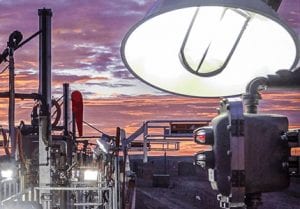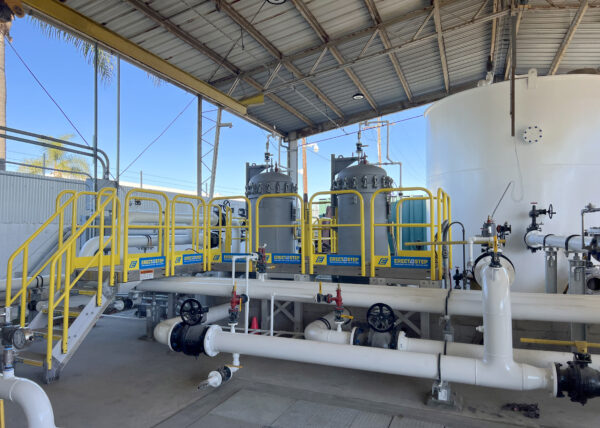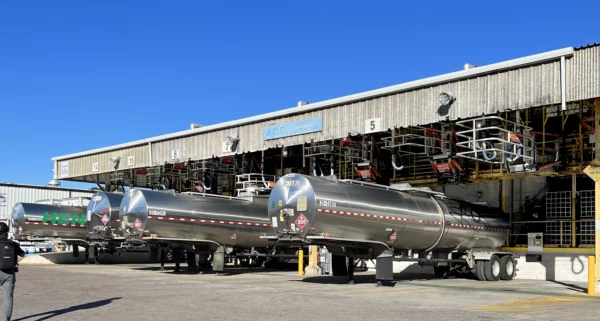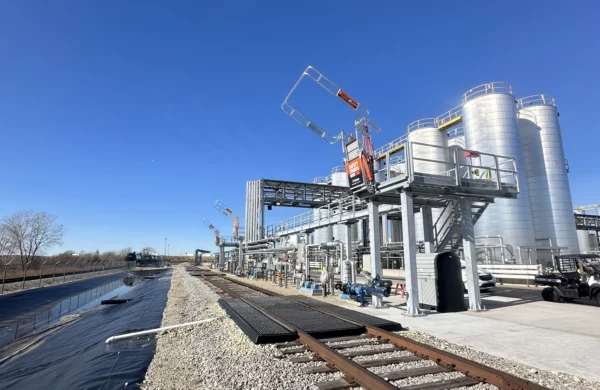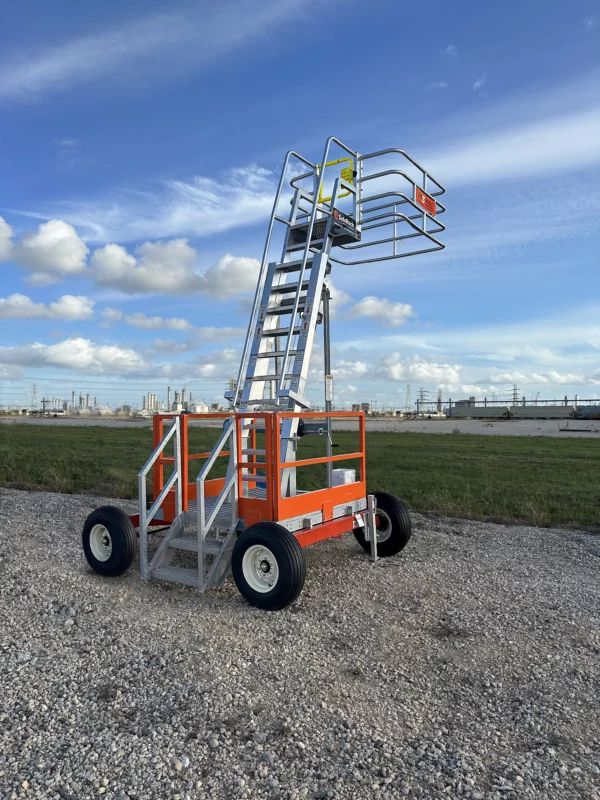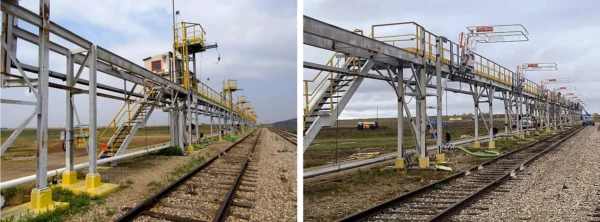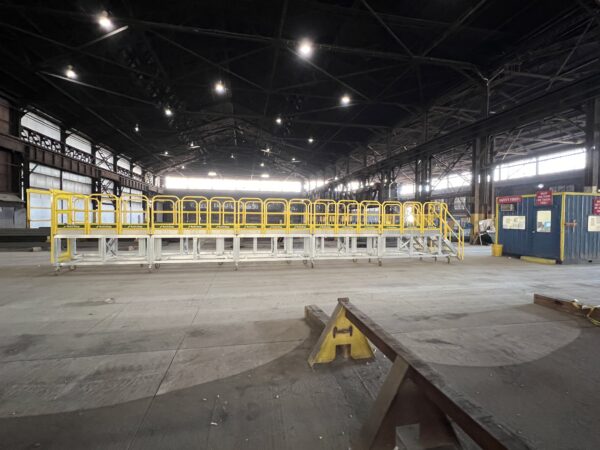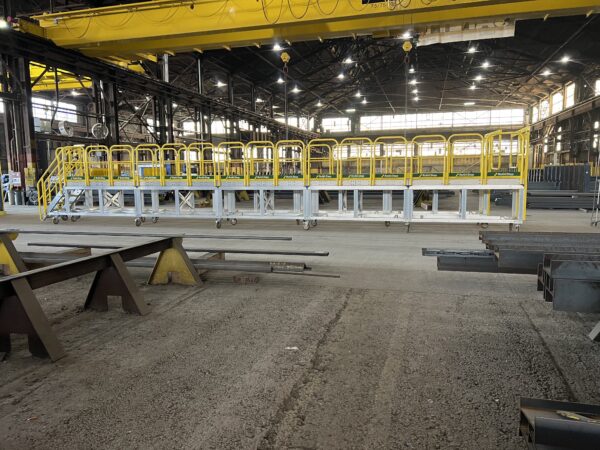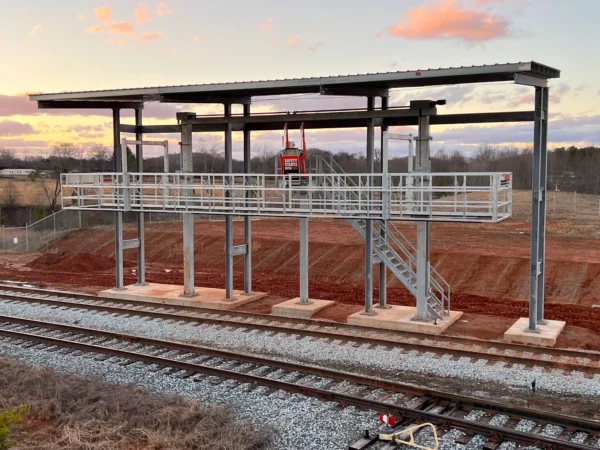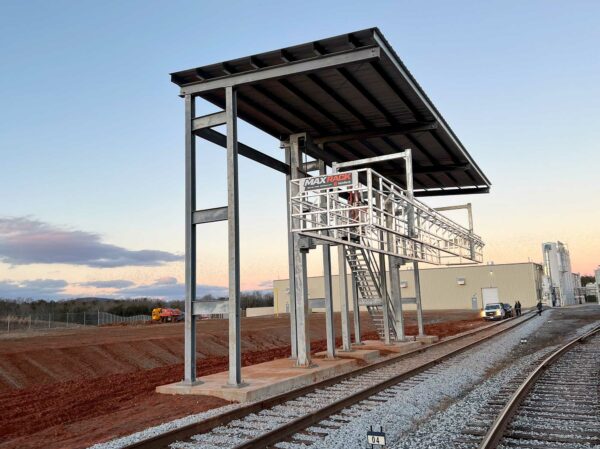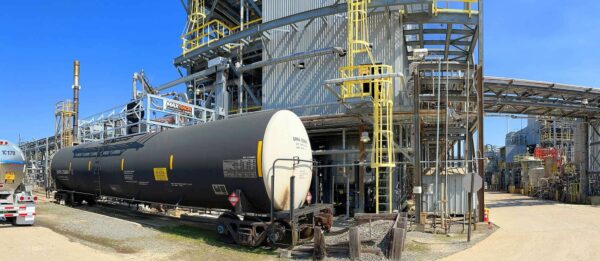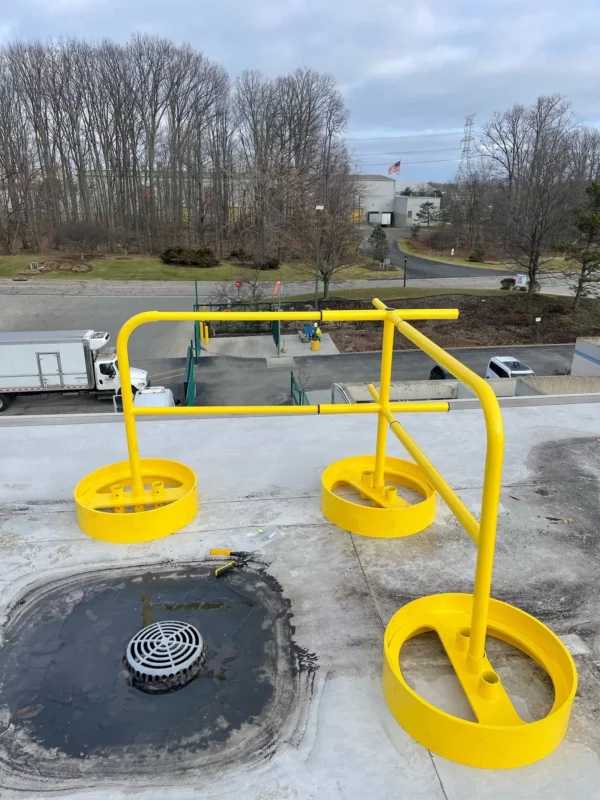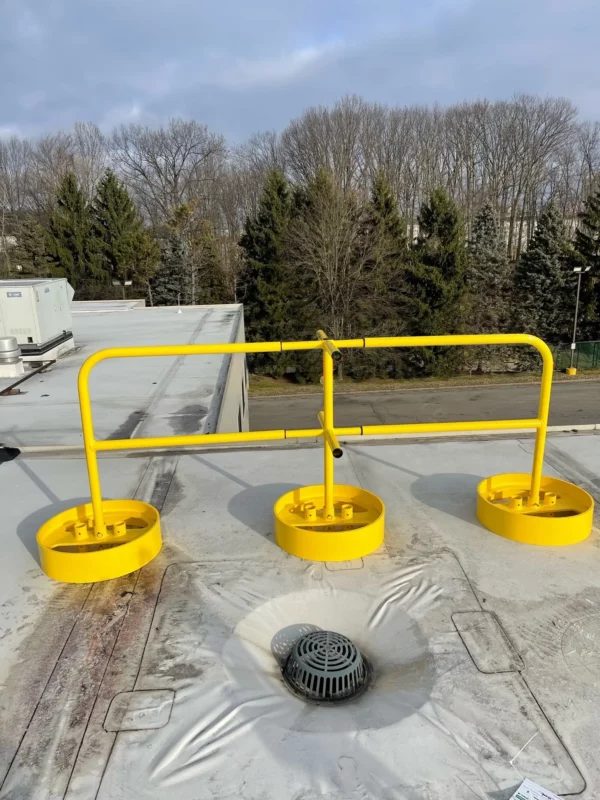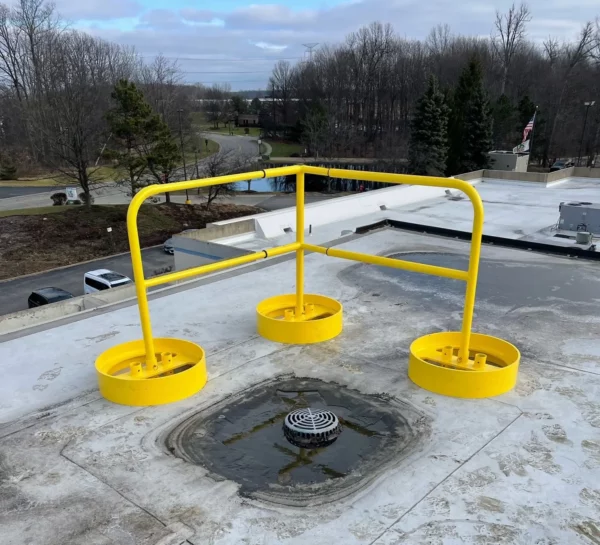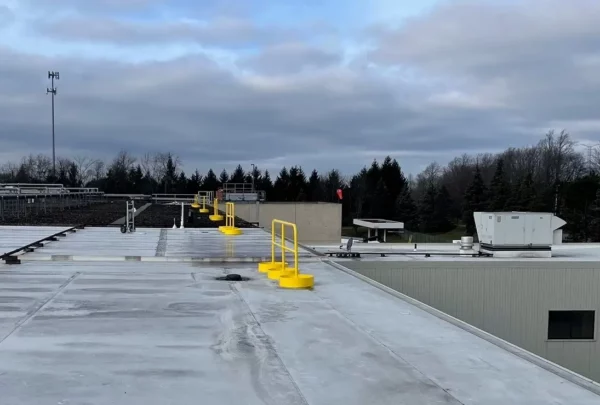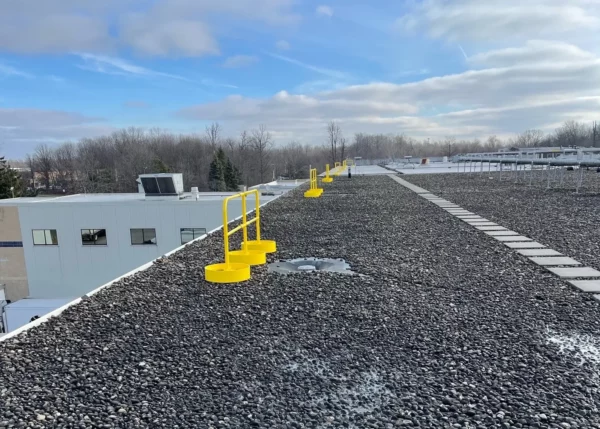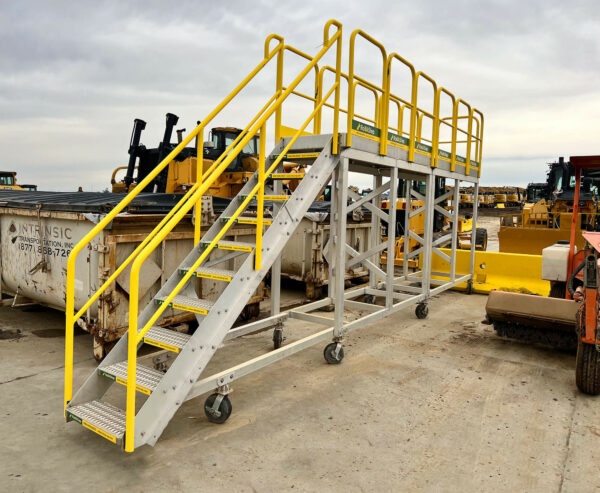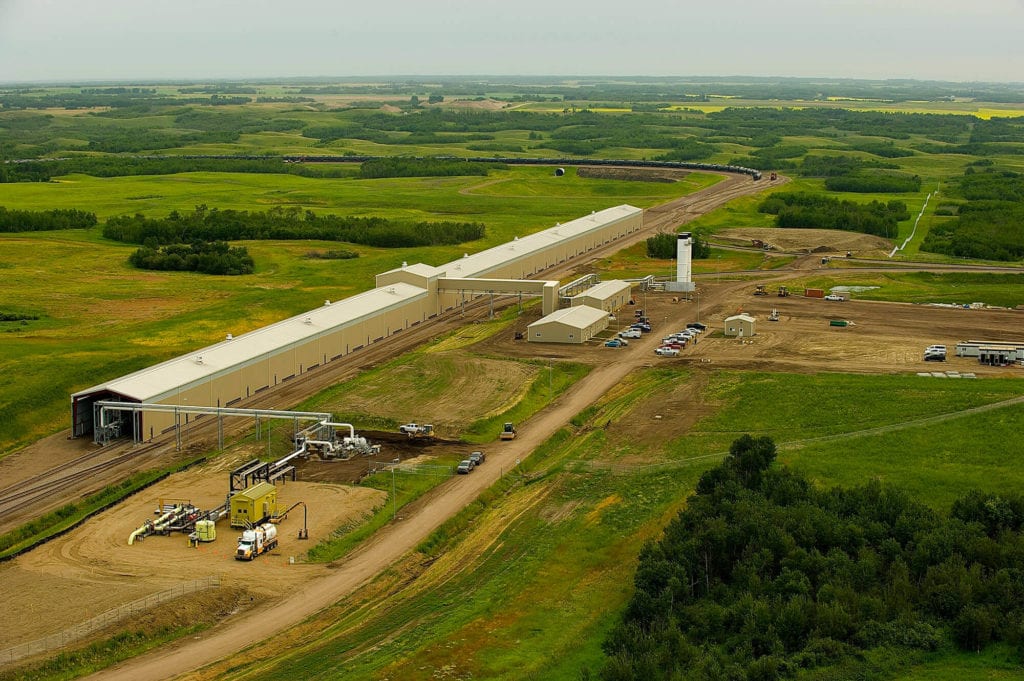Get a quote, configure a custom safety solution or ask a question. We're here to help!








- Spill ContainmentMore …Loading Safety CagesMore …
SafeRack Worldwide
We pride ourselves on one-on-one customer service. When you call SafeRack, we'll be there to answer your questions with a combined experience of 400+ years.
Select your region below.- View Products
- Railcar & Truck Loading Platforms
- Gangways & Loading Ramps
- Stairs, Platforms & Ladders
- Mobile Ladders & Platforms
- Loading Arms & Fluid Transfer
- Safety Gates & Traffic Control
- Aviation & Aerospace Access
- Marine Access & Loading
- Grounding & Monitoring
- Spill Containment
- Loading Safety Cages
- Transloaders & Skids
- Shelters & Canopies
- Fall Protection
- Terminal & Speciality
Home / Industries / Bulk Chemical Loading / Ethanol Handling Design, Loading, and Installation.Ethanol Handling Design, Loading, and Installation.
Although no two Ethanol Loading solutions will be identical, the product itself determines much of the critical design criteria that will ensure that optimum safety and productivity can work together in harmony.
What is Ethanol? Ethanol, also referred to as ethyl alcohol, or grain alcohol is a clear colorless liquid and it’s a principal ingredient in alcoholic beverages. In the United States ethanol is primarily produced from the fermentation of starch in corn grain. In the fuel industry, bio-refineries use state-of-the-art technologies to convert grains, food wastes, cellulosic biomass and other feedstocks into high-octane ethanol.
Ethanol is typically shipped in 26,000 to 30,000 gallon DOT-111 insulated or non-insulated tank cars with safety valves. However, the newly mandated 2015 FAST Act ruling requires that all tank cars moving flammable liquids must be retrofitted to meet the new DOT-177J and 177R tank car specifications. The ruling also establishes a timeline of May 1st, 2023 to phase-out tank cars that don’t meet the new specification.




























Question, Get a Quote, Live Demo or Request an On-Site Visit
Our experts simplify the complex
View Full TextTank truck (un)loading procedures are similar to railcar applications with the trailers meeting established DOT requirements for transporting ethanol or other like commodities. Approved trailers include MC 306/DOT 406 low pressure trailers. Road trailers are bottom unloaded and equipped with pressure relief valves.
Ethanol is a flammable, colorless, and slightly toxic chemical compound. It shares similar chemical properties to gasoline and because of that ethanol has evolved into a fuel substitute and fuel additive. It’s also used to oxygenate gasoline mixtures, which in turn allows fuel to burn more completely, which results in cleaner emissions and better air quality.
Your Project
Typically, as a starting point, we will need to know answers to these questions for your project
- The Railcar connection locations need flexibility – Do you know what the breadbasket connections look like?
- Are you using liquid and vapor arms/hose as two separate devices or a piggyback arm?
- Is the loading station indoors or outdoors?
- Is the loading area temperature controlled?
- How are you going to spot your railcars
Our highly trained technical sales team will undertake a detailed site survey prior to undertaking any work to check and clarify all dimensions, obstructions, access issues and other salient points. Our challenge is to provide the safest working environment – protecting operators and the equipment – while simultaneously enabling you to improve throughput and productivity.
Your Project Needs
Whether you are looking for a turn-key installation, on-site supervision or a maintenance program, SafeRack is positioned to assist you. We can do as little or as much as you need. Our project management and supervision team is the best in the business at supporting your company’s needs.
- Collaborative Design – Our loading platform specialists will work with you one on one, if you design to design the best loading solution for your specific needs
- Contract review – drawings and associated documents relating to the contract prior to site arrival
- Risk Assessment – Undertaking a site risk assessment
- Shipment Inspection – Detection of any shipping damage or abnormalities
- Material Receiving – Supervised off-loading and transport at site
- Installation Management – Supervised Installations and Coordination
- Start-up & Commissioning – On-site training for both users and maintenance personnel
Loading Arms
Generally speaking, SafeRack recommends rigid pipe loading arms where possible for the following reasons:
- Balanced throughout their movement envelope
- Designed not to hit the ground – protecting the asset and the operator
- Ergonomic – one man operation
- Fitted with manual or actuated valves.
- Fitted with optional purge/vent facilities
- Can be moved into position with ease and left hanging in the air while the operator prepares the tanker connection
- Parked neatly
Hoses require:
- Annual pressure test
- Are difficult to stow neatly when not in use
- Can be dropped
- Can be driven over
- Are very heavy to use if fitted with a valve at the tanker connection point
- Cannot be easily heated or have vent/purge valves fitted to it
- Prone to catastrophic failure
In the United States, Ethanol is primarily a open dome or “splash loading” operation and is loaded into rail cars via 4” to 6” boom-supported carbon steel or CS and aluminum loading arms. Ethanol, if not handled properly can cause injuries; therefore Personal Protective Equipment (PPE) is required. Additionally, because operators are on top of the vehicles during the loading process, robust, well-designed fall prevention is essential to ensure increased throughput, without compromising operator safety.
Ethanol-blended fuels are transported in various types of containers including tank trucks, rail cars, barges, and pipelines.
Typical Ethanol Loading Platform
Quote or discuss your installation.
Start by selecting loading application"*" indicates required fields
Below are some of the loading and unloading solutions for illustrative purposes only. Our experts will work with you and your team for a custom solution to suit your needs.
Ethanol Loading Arms

Ethanol is typically loaded into railcars or tank trucks via a fixed reach or boom supported carbon steel loading arms with aluminum sub-components (i.e. aluminum drop tube) The arm will have a top inlet with a control valve to ensure that it is self-draining after use. Additional arm components may include, high level sensor probe, or parking latches with proximity sensors to ensure the arm is properly stowed when not in use, and more importantly before any rail car or truck movement can occur. Railcar unloading typically includes a sweeping aluminum elbow attached to the belly valve connected to either a self-draining stainless or CS loading arm or petroleum hose with emergency breakaways and flanged end connections.
Road tanker unloading would typically involve petroleum hoses or bottom (un)loading arms with API couplers attached to the under belly or lower rear of the trailer.
Ethanol Loading Gangways and Safety Cages

A wider access gangway (48″-60″ is preferable) as it helps improve access and egress to and from the vessel. In addition, a wider gangway will reduce the risk of the operator’s PPE getting caught, torn or damaged, and will improve productivity and safety. Powered gangway solutions are also an option, with both hydraulic and pneumatic solutions being commonly used. Each gangway will be fitted with a two-rail safety cage for the railcar crash box. This will be a centered 6’x6′ safety cage to sit directly over the cashbox. This will provide a safe, secure work environment for your operator when connected to their breathing apparatus

SafeRack’s GX SAS gangways use Retractalok power-assist technology allowing operators to raise or lower effortlessly, light as a feather to lift, and solid as a rock. Tested in the most critical applications, this revolutionary new gangway outperforms all others. Available in multiple lengths and widths.
Learn MoreMAXRack Elevating Safety Cage
 As an alternative to our two and four-rail safety cages, some customers prefer our MAXRack elevating safety cages. The ultimate fall prevention solution engineered to keep operators safe and productive. Designed for both trucks or railcars, and available in multiple cage lengths and widths. Safe, durable, and easy to use. MAXRack is built rock-solid with galvanized steel column supports and lifting arms (cages can be Aluminum, Galvanized, or Stainless Steel depending on application) Available in two power options – Pneumatic Air Drive and Electric Drive (Explosion and Non-Explosion Proof).
As an alternative to our two and four-rail safety cages, some customers prefer our MAXRack elevating safety cages. The ultimate fall prevention solution engineered to keep operators safe and productive. Designed for both trucks or railcars, and available in multiple cage lengths and widths. Safe, durable, and easy to use. MAXRack is built rock-solid with galvanized steel column supports and lifting arms (cages can be Aluminum, Galvanized, or Stainless Steel depending on application) Available in two power options – Pneumatic Air Drive and Electric Drive (Explosion and Non-Explosion Proof).
Learn MoreEthanol Eye Wash/Drench Showers

ANSI guidelines state that an Eye Wash/Drench Showers need to be located 10 seconds or 55′ (16.8m) from contaminants or hazardous materials. Eyewash stations need to be on the same horizontal plane with no obstructions.
Therefore, we would propose the installation of a standard combination Drench Shower/Eyewash Unit, which will save limited space and fit easily into any work environment.
Ethanol Spill Containment

Spill containment pans will be provided at the point of loading operations and is an essential piece of equipment in overall site safety and environmental protection Ethanol Grounding

Ethanol is not normally combustible. However risk of fire does exist in the presence of TRS gases. These fumes are flammable and can be ignited by heat or flame. Vapors have been known to travel back to ignition sources and flashback. - Vehicle grounding and bonding — ensure true grounding before product flow is permitted
- Explosion-proof enclosures — meet or exceed UL, CSA, and Ex requirements
- Non-sparking tools are also recommended while working around this product
Ethanol Safety Gates

Safety Gates will be installed at the top of stairs and any other openings to ensure operator safety at all times.  YellowGate Safety Gates
YellowGate Safety GatesSafeRack’s line of industrial safety gates is the most flexible product on the market with the ability span openings between 16″ and 36″ and is field adjustable with nothing more than a wrench. Learn More
Ethanol Options

- Lighting – Lighting both over and under the platform will be provided. For overcast days or second shift, lighting is essential for improved safety and improved productivity.
- Platform & Canopies – Full platform canopies reduce exposure to the elements and improve the safe and productive loading operation from the operator’s perspective.
- Operator Shelter – Depending on your site requirements, consideration should be given to the requirement of an operator or guard building on the loading platform. This can be customized to meet specific site requirements.
- Wheel Chocks – Railcar Wheel Chocks provide fast blocking of all types of railcars and meet OSHA regulations to safely prevent railroad cars from moving during loading or unloading operations. This is a requirement by the Department of Homeland Security.
Personal Protective Equipment PPE Requirements
Mandatory Safety Attire: H2O2 should never come in contact with combustible materials such as cloth or leather. Stepping in even a small puddle of concentrated H2O2 can initiate combustion of leather footwear.
Eye/Face Protection: Wear “snug fitting” chemical safety goggles with a full face shield.
Skin Protection: Wear chemical protective clothing e.g. gloves, aprons, boots. Best practice includes protective chemical, full-body encapsulating suit made of vinyl, neoprene, PVC or polyethylene. As well as, a self-contained breathing apparatus (SCBA). Suitable materials include: butyl rubber, Viton®, Viton®/butyl rubber, Barrier® – PE/PA/PE, Silver Shield® – PE/EVAL/PE, Trellchem® HPS, Trellchem® VPS, Saranex®™, Tychem® BR/LV, Tychem® Responder® CSM, Tychem® TK. The following materials should NOT be used: neoprene, nylon, polyvinyl chloride
Respiratory Protection: Up to 5 ppm:
(APF = 10) Any chemical cartridge respirator with cartridge(s) providing protection against chlorine*; or Any supplied-air respirator*.
*Reported to cause eye irritation or damage; may require eye protection.
APF = Assigned Protection Factor
Recommendations apply only to National Institute for Occupational Safety and Health (NIOSH) approved respirators. Refer to the NIOSH pocket guide to chemical hazards for more information.
Use a local exhaust ventilation and enclosure, if necessary, to control the amount in the air. Consider using a corrosion-resistant exhaust ventilation system separate from other ventilation systems. It may be necessary to use stringent control measures such as process enclosure to prevent product release into the workplace. Use backup controls (e.g. double mechanical pump seals) to prevent the release of this material due to equipment failure. * For illustrative purposes only. Our experts will work with you and your team for a custom solution to suit your needs Customer Reviews
 5 5This product is easy to set up, move, and change.
5 5This product is easy to set up, move, and change.This product is easy to set up, move, and change to a different configuration if needed… stability, interchangeable, light weight.
By Chris Jones from MarkWest Liberty Midstream on 4/25/16 5 5We needed a barrier gate to help us reduce rack damage, saving money and time in the future.
5 5We needed a barrier gate to help us reduce rack damage, saving money and time in the future.It has not been delivered yet but is on its way. While we would love to have it here earlier we understand that product availability is not always immediate. We feel the salesperson explained that this barrier gate should drastically help reduce that!
By Steven Dew from Alpine Silica on 6/30/19 5 5Very Satisfied with our new platform system
5 5Very Satisfied with our new platform systemThe best part for us was how knowledgeable and helpful the salesman was…we had a strange need and he understood our need and worked with us to find a product that worked. Very Satisified.
By John Kirschner from Oconee Cultural Arts Foundation on 12/3/20 4 5They have proven to be well made and hold up well.
4 5They have proven to be well made and hold up well.We have several of these in use at our plant and they have proven to be well made and hold up well. The aluminum design has saved use cost due to drivers being able to raise them easier and not letting them get hung on the trucks.
By Steve from CEMEX on 5/4/15 5 5Easy to maneuver and operate.
5 5Easy to maneuver and operate.I would recommend the SafeRack MAUI for trucks – it’s easy to maneuver and operate.
By Jerry Crowder from Kinder Morgan on 6/1/11 5 5The product was delivered within the week.
5 5The product was delivered within the week.My salesperson was always responsive, within 24hrs of reaching out. The YellowGate is exactly what we were looking for.
By JR Dunz from Healing Place Church on 11/15/16Ethanol 101
Things to know about Ethanol
Ethanol is regulated by the U.S. Department of Transportation (DOT) and is classified as a flammable and combustible liquid with the DOT identification number UN 1170.
Since there are various ethanol blended fuels being transported over the road and by rail in the U.S. and around the world. Consistent and proper labeling of ethanol while in transit helps first responders in identifying the product in the event of an emergency.
Only properly trained and equipped personnel should be permitted to (un)load Ethanol tank cars and tank trucks. Operators should wear approved PPE equipment including impervious clothing, footwear, gloves, and goggles.
Ethanol can be dangerous to human health, and acute exposure can cause skin and eye irritation. Do not breathe fumes, mist, or vapors. Handle only outdoors, or in a well ventilated area.
First aid measures for exposure include – removing operators from the source of exposure and into fresh air. Remove contaminated clothing immediately; wash skin thoroughly with soap and water; flush eyes with tepid water for 15 minutes. If ingested do not induce vomiting, but immediately call your local poison control center. Aspiration into the lungs can cause fatal chemical pneumonitis. If ingestion has occurred, assume there is a risk of aspiration into the lungs.
Ethanol, similar to gasoline is highly flammable; best practice includes keeping away from open flames, hot surfaces, and sources of ignition.
Ethanol blends tend to be incompatible, meaning they degrade over time, with brass, lead, and zinc, so care should be taken to avoid long term exposure with these metals. Degradable non-metallic materials include natural rubber, polyurethane, cork gasket material, leather, polyvinyl chloride, and certain thermoplastic.
However, aluminum, bronze, and stainless steel have shown resistance to ethanol corrosion. Non-metallic materials such as reinforced fiberglass, Neoprene & Nitrile rubber, polypropylene, Viton, and Teflon meet acceptable usage requirements.

Is your plant or facility compliant with ANSI, OSHA, and local safety codes? We can help!


EMERGENCY EYEWASHES / SHOWER EQUIPMENT AND THE ANSI/ISEA Z358.1 – 2014 STANDARD
Following eye contact, you must start washing with water immediately to prevent permanent damage. In the event of skin contact, you must start washing with water immediately to prevent slow-healing chemical burns.
Are you aware that ANSI guidelines state that Eye Wash/Drench Showers need to be located 10 seconds or 55′ from contaminates or hazardous materials and located on the same horizontal plane, with no obstructions? If bottom loading/unloading, an additional shower should be located at grade as well. SafeRack provides the above equipment plus much more needed to keep employees safe and expedite bulk chemical loading and unloading.
OSHA Regulation Experts – Does your existing chemical safety equipment or chemical loading systems meet OSHA’s latest requirements? SafeRack’s professional technical sales consultants are available to meet with your team to make recommendations to keep your facility in front of OSHA’s ever-changing country and region-specific standards and regulations, including lifeline and trolley beam fall arrest systems, metal stairs, and access platforms.
Why SafeRack?
The SafeRack approach is a collaborative one. Let’s call it The SafeRack Way. We have, over many years amassed a great deal of experience and understanding of the safety aspects involved in loading road tankers and railcars, as well as the behavioral habits of the operators.

Experts In Chemical Loading
- Acetic Acid
- Acetic Anhydride
- Acetonitrile
- Acrolein
- Acrylic Acid
- Acrylonitrile
- Aluminum Chloride
- Aluminum Sulfate
- Ammonia
- Ammonium Hydroxide
- Ammonium Nitrate
- Aniline
- Benzene
- Benzyl Chloride
- Bromotrifluoromethane
- Butadiene
- Carbon Dioxide
- Caustic
- Chlorine
- Chloroform
- Chlorosulfonic Acid
- DEF (Diesel Exhaust Fluid)
- Diethylene Glycol
- Dimethylformamide
- Dodecylbenzene Sulfonic Acid
- Ethanol
- Ethyl Acetate
- Ethyl Chloride
- Ethylene
- Ethylene Dichloride
- Ethylene Glycol
- Ethylene Oxide
- Ferric Chloride
- Ferrous Chloride
- Hexane
- Hydrochloric Acid
- Hydrofluoric Acid
- Hydrofluorosilicic Acid
- Hydrogen Cyanide
- Hydrogen Peroxide
- Hydrofluoric Acid
- Hypochlorous Acid
- Isopropyl Acetate
- Liquid Argon
- Liquid Nitrogen
- Liquid Oxygen
- Maleic Anhydride
- MDI
- Methanol
- Methyl Chloride
- Methyl Ethyl Ketone
- Methyl Methacrylate
- Methyl Isocyanate
- Molten Sulphur
- Nitric Acid
- Oleum
- Phenol
- Phosphoric Acid
- Phosphorus Oxychloride
- Phosphorus Trichloride
- Polypropylene
- Renewable Diesel
- Sodium Cyanide
- Sodium Hydroxide
- Sodium Hypochlorite
- Styrene Monomer
- Sulfuric Acid
- Sulfur Dioxide
- Titanium Tetrachloride
- Toluene
- Toluene Diisocyanate
- Turpenitne
- UAN (Urea Ammonium Nitrate)
- UREA
- Vinyl Acetate
- Vinyl Chloride
- Xylene
- Zinc Chloride
- Agro-Chemical
- Specialty Chemical
- Petrochemical

North America’s largest loading terminal
World-leading designer, manufacturer, and installer of truck and railcar loading platforms
As one of the primary railcar loading points, Hardisty is one of the major crude oil hubs in North America and a major origination point of pipelines that export to the United States. SCS was asked to supply and construct a SafeRack crude oil loadout terminal spanning nearly half a mile. The USD Hardisty terminal can load up to two 120-railcar unit trains per day and consists of a fixed loading rack with 62 railcar loading positions enclosed, separate control, operator, and mechanical buildings, as well as a unit train staging area and loop tracks capable of holding multiple unit trains simultaneously. SCS also supplied and installed boom-supported loading arms with supply and vapor management systems.

Quick Quote 866-761-7225
LET US DESIGN YOUR SOLUTION TODAY
Our innovative tools provide 3D visualizations and accurate quotes in minutes.
Get Help NowOrder Now 866-761-7225
Questions or Need a Quote?
Chat live with a knowledgeable and friendly safety expert now.

Bob Kashtan
Located in South Carolina

Joey Robinson
Located in South Carolina

Caelin Lacy
Located in South Carolina

Katie Kelly
Located in South Carolina

Amber Graham
Located in South Carolina














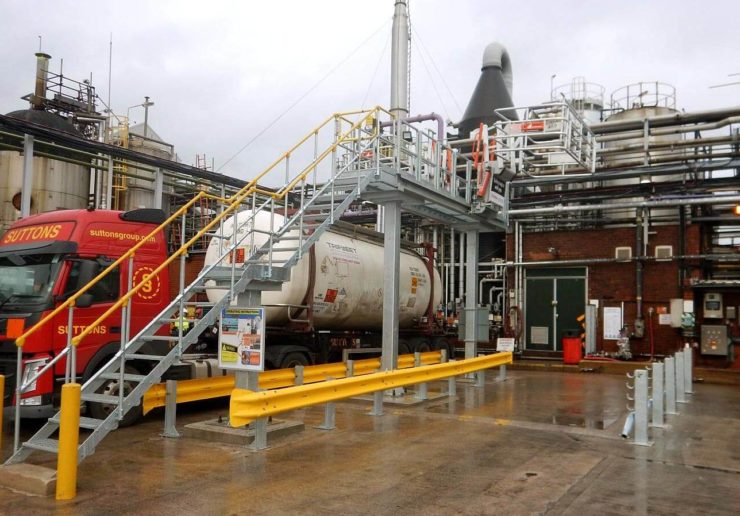
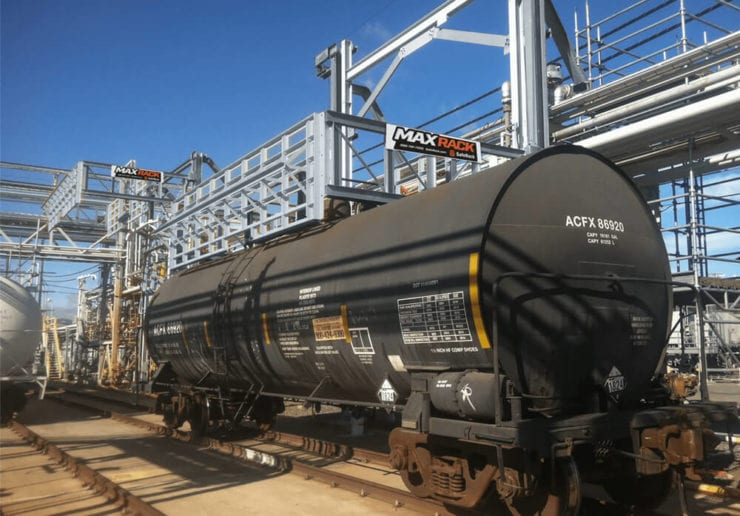


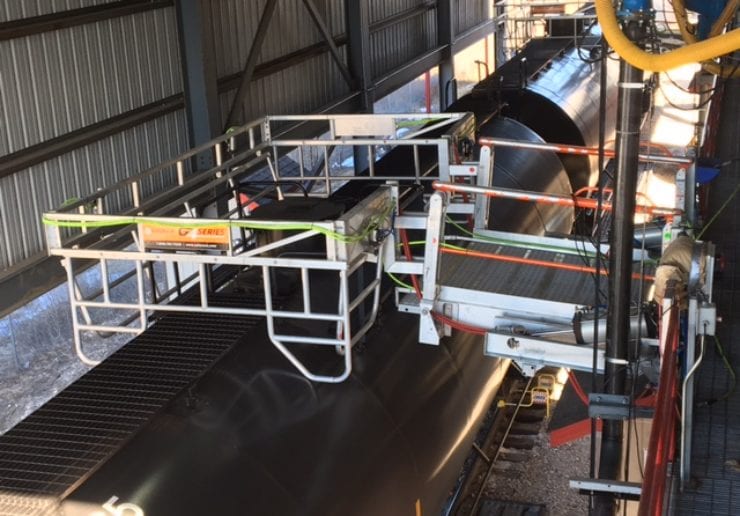
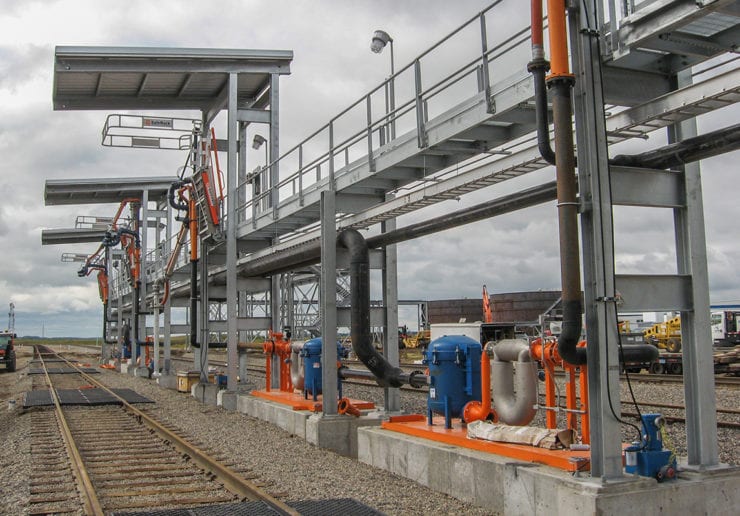
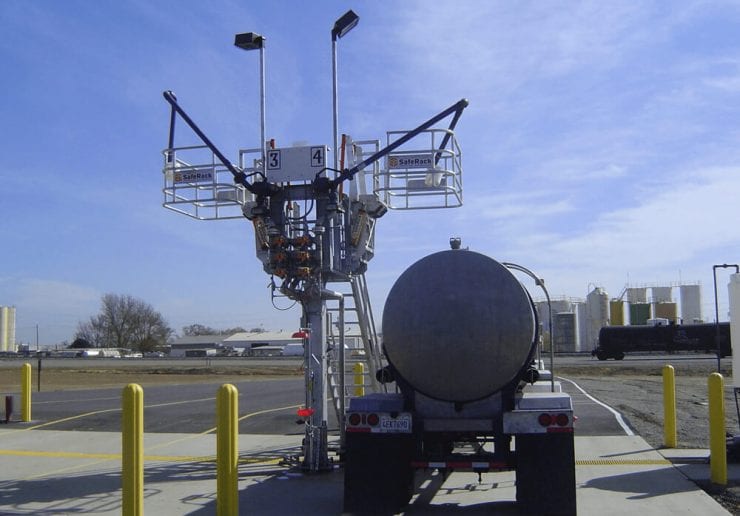
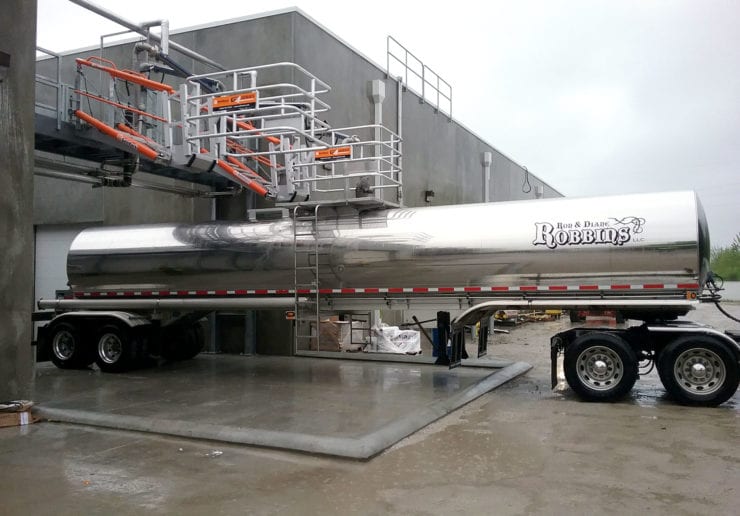
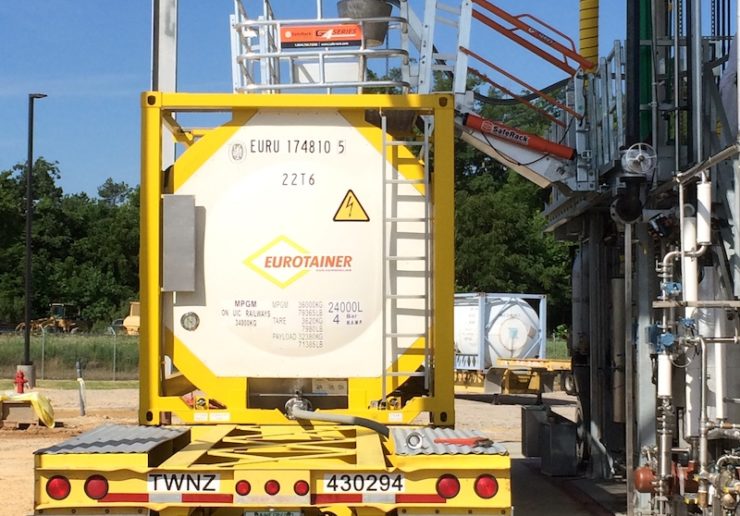
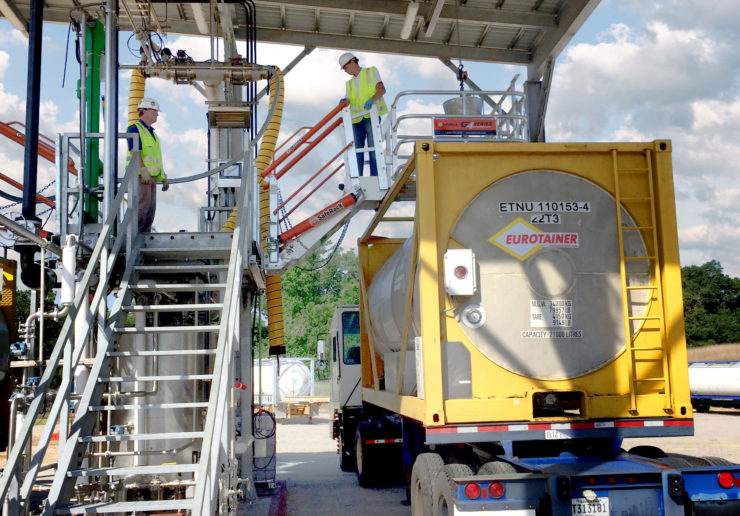




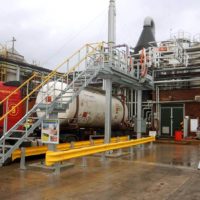
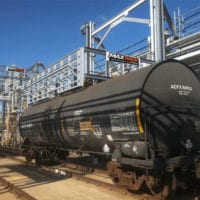
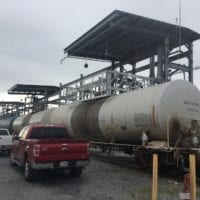
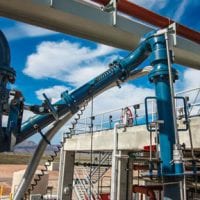
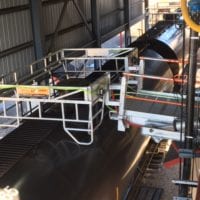
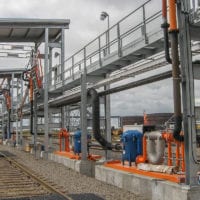
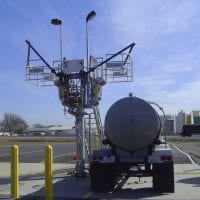

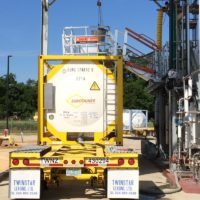
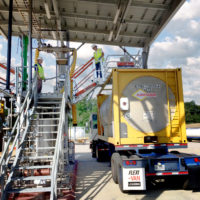



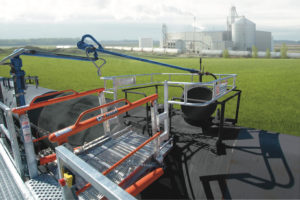
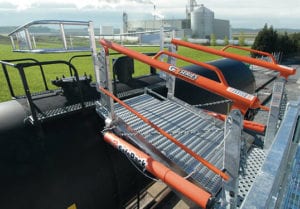
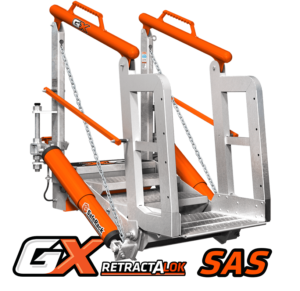
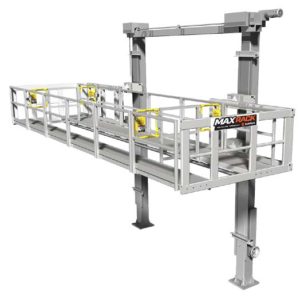 As an alternative to our two and four-rail safety cages, some customers prefer our MAXRack elevating safety cages. The ultimate fall prevention solution engineered to keep operators safe and productive. Designed for both trucks or railcars, and available in multiple cage lengths and widths. Safe, durable, and easy to use. MAXRack is built rock-solid with galvanized steel column supports and lifting arms (cages can be Aluminum, Galvanized, or Stainless Steel depending on application) Available in two power options – Pneumatic Air Drive and Electric Drive (Explosion and Non-Explosion Proof).
As an alternative to our two and four-rail safety cages, some customers prefer our MAXRack elevating safety cages. The ultimate fall prevention solution engineered to keep operators safe and productive. Designed for both trucks or railcars, and available in multiple cage lengths and widths. Safe, durable, and easy to use. MAXRack is built rock-solid with galvanized steel column supports and lifting arms (cages can be Aluminum, Galvanized, or Stainless Steel depending on application) Available in two power options – Pneumatic Air Drive and Electric Drive (Explosion and Non-Explosion Proof).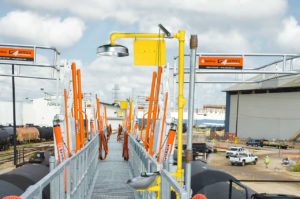
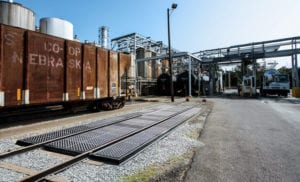
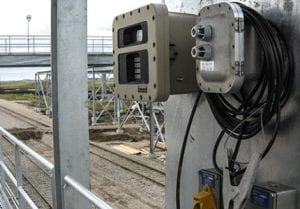
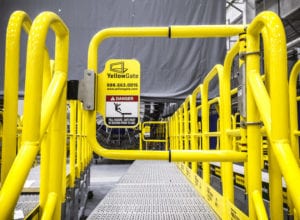
 YellowGate Safety Gates
YellowGate Safety Gates